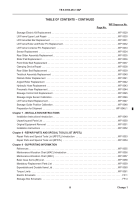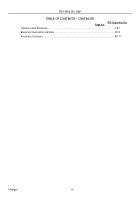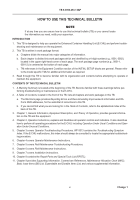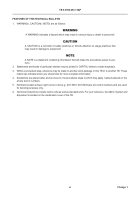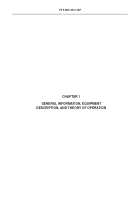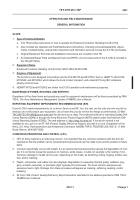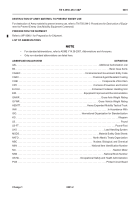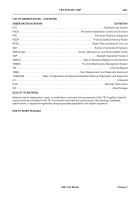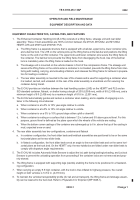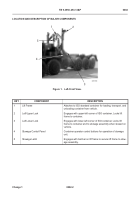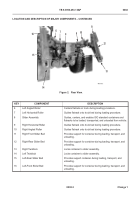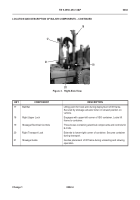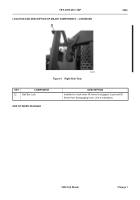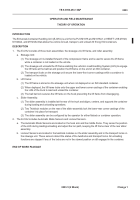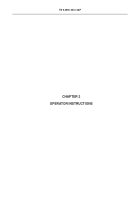TB-9-3950-253-13-P
PALLETIZED LOAD SYSTEM TRUCK, M1075 and M1075A1 (PLS) AND HEAVY EXPANDED MOBILITY TACTICAL TRUCK, M1120, M1120A2, AND M1120A4 (HEMTT), ENHANCED CONTAINER HANDLING UNIT (E-CHU)
TECHNICAL BULLETIN; OPERATOR AND FIELD MAINTENANCE, INSTALLATION INSTRUCTIONS, AND REPAIR PARTS AND SPECIAL TOOLS LIST
JULY 2009
TB-9-3950-253-13-P - Page 27 of 704
0002-1
Change 1
0002
TB 9-3950-253-13&P
OPERATOR AND FIELD MAINTENANCE
-
EQUIPMENT DESCRIPTION AND DATA
EQUIPMENT CHARACTERISTICS, CAPABILITIES, AND FEATURES
0002
1. The Enhanced Container Handling Unit (E-CHU) consists of a lifting frame, stowage unit and rear slider
assembly. These 3 main assemblies are 100% common between the M1120, M1120A2, and M1120A4
HEMTT-LHS and M1075 and M1075A1 PLS.
a. The lifting frame is a separate structure that is equipped with a bail-bar, upper locks, lower container pins,
and a bail bar lock. The LHS on the vehicle picks up the lifting frame at the bail-bar and positions the lifting
frame on the end of an ISO container. The upper locks and lower container pins secure the lifting frame to
the container. The bail bar lock prevents the lifting frame from disengaging the hook. Use of the bail bar
lock is mandatory when the lifting frame is loaded on the hook.
b. The stowage unit is mounted on the vehicle chassis in front of the compression frame. The stowage unit
secures the lifting frame on the vehicle when a container is not loaded, prevents the lifting frame from inter-
fering with loading, carrying, and unloading a flatrack, and releases the lifting frame for retrieval in prepara-
tion for loading a container.
c.
The rear slider assembly is mounted to the rear of the chassis and is used for supporting a container when
it is loaded, carried, and unloaded. At the rear of the slider assembly is a twistlock unit for securing the
container during transit.
2. The E-CHU provides an interface between the load handling system (LHS) on the HEMTT and PLS and an
ISO standard container, flatrack, or shelter having a length of 20 ft (6,058 mm), width of 8 ft (2,438 mm), and a
minimum height of 8 ft (2,438 mm) to a maximum height of 8 ft 6 in. (2,591 mm).
3. The E-CHU automatically guides and centers a container when loading, and is capable of engaging a con-
tainer in the following circumstances:
a. When container is at a 0% to 10% yaw angle relative to vehicle
b. When container is at a 0% to 10% roll angle relative to vehicle.
c.
When container is on a 0% to 10% ground slope either uphill or downhill.
d. When container is resting on a surface that is between 12 in. below and 5 ft above ground level. For this
purpose, ground level is defined as the plane upon which the wheels of the vehicle are resting.
e. When the bottom corner castings of the container are submerged up to 6 in. above the top of the casting in
mud, unpacked snow or sand.
4. The rear slider assembly has two configurations, container and flatrack
a. In container configuration, the front slider beds and twistlock assemblies are positioned to be on the same
horizontal plane as the rear slider beds.
b. In flatrack configuration, the front slider beds are at an angle to the rear slider beds and on the same hori-
zontal plane as the truck bed. On the HEMTT only, the rear twistlocks are folded under rear slider beds to
comply with departure angle requirements.
5. The E-CHU kit includes Automatic Mode Sensors to adjust the loci path during loading/unloading, and Lockout
Sensors to prevent the unloading operation from proceeding if the container locks are not removed and prop-
erly stowed.
6.
The lifting frame is equipped with supporting legs (stands) enabling the frame to be positioned in a freestand-
ing configuration.
7. When carrying an empty 8 ft high container, with the truck’s tires inflated to highway pressure, the overall
height on both vehicles is 14 ft 2 in. (4,318 mm).
8. To maintain the vehicles transportability profile (for rail and air transport), the lifting frame and stowage assem-
bly can be lowered to the truck bed. Refer to
Preparation for Shipment
(WP 0048.1).
6
Back to Top

